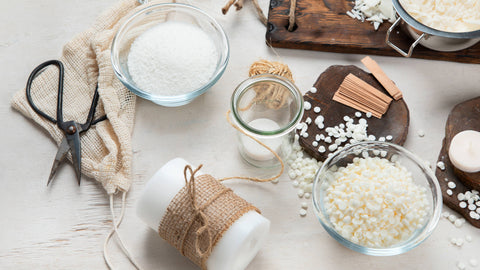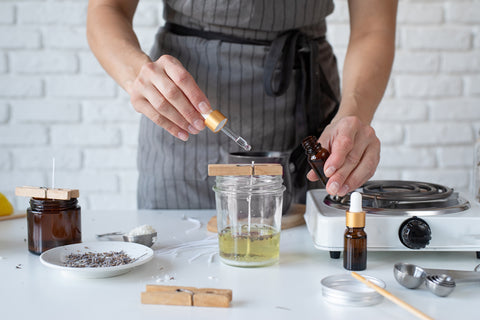Title: Exploring the World of Candle Making: A Comprehensive Guide to Supplies and Techniques
Introduction
Candle making has been a cherished craft for centuries, providing warmth, light, and ambiance to our homes and events. Making your own candles not only allows for personalization but also offers a creative outlet and the satisfaction of creating something beautiful and fragrant. In this comprehensive guide, we will explore the essential candle making supplies, from candle wax and fragrance oils to candle jars and wicks. We will also delve into techniques, such as using soy wax, essential oils, and the art of scent blending. So, let's gather our tools and dive into the captivating world of candle making!
I. Essential Candle Making Supplies
-
Candle Making Kit:
- The first step in your candle-making journey is investing in a quality candle making kit.
- A candle making kit typically includes essential tools such as a melting pot, thermometer, stirring utensils, and candle molds.
- Kits are often tailored to specific candle types, such as container candles or pillar candles.
-
Candle Wax:
- Candle wax is the foundation of every candle, determining its burn time, appearance, and characteristics.
- Soy wax, derived from soybean oil, is beloved for its natural and renewable qualities.
- Paraffin wax, a petroleum-based wax, is widely used for its affordability and excellent scent throw.
- Beeswax, a natural wax produced by bees, offers a beautiful, honey-like scent and a long-lasting burn.
-
Candle Scents and Fragrance Oils:
- Choosing the right candle scents is essential for creating captivating candles.
- Fragrance oils are specifically formulated for candle making and offer a wide range of scents, from floral and fruity to woody and exotic.
- Essential oils can also be used, providing natural aromas and potential therapeutic benefits.
-
Candle Wicks:
- Candle wicks are responsible for igniting and sustaining the flame.
- Different wick sizes and materials are used depending on the candle size and wax type.
- The Candle Science Wick Guide is a valuable resource for selecting the right wick for your candle.
-
Candle Jars and Containers:
- Candle jars and containers not only hold the wax but also add aesthetic appeal to your finished product.
- Glass candle jars, available wholesale, are a popular choice due to their transparency, allowing the beauty of the flame to shine through.
- Other container options include metal tins, ceramic pots, and even recycled containers.
-
Candle Dye and Colorants:
- Candle dye is used to add color and visual appeal to your candles.
- Dyes come in various forms such as liquid, chips, or blocks and are available in a wide range of vibrant shades.
- It's important to follow the recommended usage guidelines for each specific dye to ensure safe and consistent results.
-
Additional Supplies:
- Candle making also requires other essential supplies such as a pouring pitcher, a heat source (stove or electric burner), a kitchen scale for precise measurements, and heat-resistant gloves for safety.
II. Techniques and Tips for Candle Making
-
Using Soy Wax:
- Soy wax, a popular choice among eco-conscious candle makers, offers a clean-burning and environmentally-friendly alternative to paraffin wax.
- Soy wax also has excellent fragrance retention, allowing for a stronger and longer-lasting scent throw.
- Its low melting point and easy cleanup make it ideal for beginners.
-
Essential Oils for Candle Making:
- Essential oils are derived from natural plant materials and offer a wide range of captivating scents.
- When using essential oils, it is important to consider their flashpoint and compatibility with the wax type.
- Blending different essential oils can result in unique and personalized fragrance combinations.
-
Scent Blending and Layering:
- Experimenting with scent blending can take your candle-making skills to the next level.
- By combining different fragrance oils or essential oils, you can create your own signature scents.
- Layering scents in a candle offers complexity and depth, with different fragrances revealed as the candle burns.
-
Wax Appearance Temperature:
- Understanding the appearance temperature of your wax is crucial for achieving the desired look and texture of your candles.
- Different waxes have different appearance temperatures, which can affect the surface finish, crystallization, and adhesion of the wax.
III. Getting Started with Candle Making
-
Preparing Your Workspace:
- Set up a dedicated area for candle making with ample workspace and good ventilation.
- Protect surfaces with newspaper or a heat-resistant mat.
- Gather all your supplies and ensure they are clean and free from debris.
-
Melting the Wax:
- Using a double boiler or a dedicated melting pot, melt the candle wax over medium heat.
- Use a thermometer to monitor the temperature and prevent overheating, as excessive heat can affect the properties of the wax and fragrance.
-
Adding Fragrance:
- Once the wax has reached the recommended temperature, usually around 180-185°F (82-85°C) for soy wax, remove it from the heat source.
- Stir in the fragrance oil, following the manufacturer's recommended usage rate.
- Be sure to mix the fragrance thoroughly to ensure even distribution.
-
Preparing the Candle Jars:
- Place pre-tabbed wicks in the center of your clean and dry candle jars.
- Use wick stickers or a small dab of hot glue to secure the wicks to the bottom of the jars.
- Use a wick centering device to keep the wicks centered during the pouring process.
-
Pouring the Wax:
- Slowly pour the scented wax into the prepared jars, being careful not to disturb the wicks.
- Leave a small gap at the top of the jar to allow for proper cooling and prevent the wax from overflowing.
-
Cooling and Finishing:
- Let the candles cool and solidify undisturbed for several hours or overnight.
- Trim the wick to a desired length, usually around ¼ inch (0.6 cm), before lighting the candle.
- Personalize your candles with labels, tags, or decorative elements for a professional touch.
Conclusion
Candle making is a captivating and rewarding hobby that allows you to express your creativity while surrounding yourself with beautiful scents and ambiance. By understanding the essential candle making supplies, such as candle wax, fragrance oils, and candle jars, and by mastering techniques like scent blending and working with soy wax, you can create exquisite candles tailored to your preferences. Whether you're a beginner or an experienced candle maker, embrace the artistry and enjoy the process of bringing light and fragrance into your life through the enchanting world of candle making.



Comments (0)
There are no comments for this article. Be the first one to leave a message!